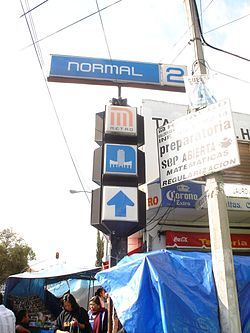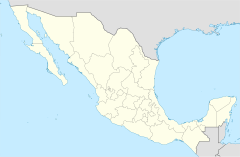
The Tlatelolco massacre was a military massacre committed against the students of the National Autonomous University of Mexico (UNAM), the National Polytechnic Institute (IPN), and other universities in Mexico.

Luis Echeverría Álvarez was a Mexican lawyer, academic, and politician affiliated with the Institutional Revolutionary Party (PRI), who served as the 57th president of Mexico from 1970 to 1976. Previously, he was Secretary of the Interior from 1963 to 1969. At the time of his death in 2022, he was his country's oldest living former head of state.

Gustavo Díaz Ordaz Bolaños was a Mexican politician and member of the Institutional Revolutionary Party (PRI). He served as the President of Mexico from 1964 to 1970. Previously, he served as a member of the Chamber of Deputies for Puebla's 1st district, a senator of the Congress of the Union for Puebla, and Secretary of the Interior.
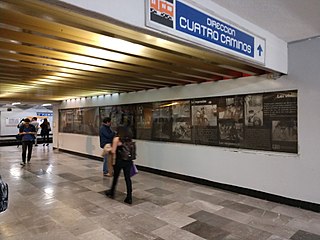
Normal is a station on Line 2 of the Mexico City Metro system. It is located in the Miguel Hidalgo municipality of Mexico City, northwest of the city centre, near the Calzada México-Tacuba. In 2019, the station had an average ridership of 35,260 passengers per day.

The protests of 1968 comprised a worldwide escalation of social conflicts, which were predominantly characterized by the rise of left-wing politics, anti-war sentiment, civil rights urgency, youth counterculture within the silent and baby boomer generations, and popular rebellions against state militaries and bureaucracies.

The Liga Comunista 23 de Septiembre, or LC23S, was a Marxist-Leninist urban guerrilla movement that emerged in Mexico in the early 1970s. The result of the merging of various armed revolutionary organizations active in Mexico prior to 1974, with the objective of creating a united front to combat the Mexican government; the name was chosen to commemorate an unsuccessful guerrilla assault on the barracks of Ciudad Madera in the northern state of Chihuahua led by former schoolteacher Arturo Gámiz and the People's Guerrilla Group on September 23, 1965. The LC23S' militancy was made up mainly of young disenfranchised university students who saw any opportunity of a peaceful political transformation die in the aftermath of the 1968 student movement and then to be buried in the violent crackdown of 1971. Its long term objective was the “elimination of the capitalist system and bourgeois democracy, which would be replaced by a socialist republic and the dictatorship of the proletariat”.

The 6 October 1976 massacre, also known as the 6 October event in Thailand, was a violent crackdown by Thai police and lynching by right-wing paramilitaries and bystanders against leftist protesters who had occupied Bangkok's Thammasat University and the adjacent Sanam Luang, on 6 October 1976. Prior to the massacre, thousands of leftists, including students, workers and others, had been holding ongoing demonstrations against the return of former dictator Thanom Kittikachorn to Thailand since mid-September. Official reports state that 46 were killed and 167 were wounded, while unofficial reports state that more than 100 demonstrators were killed. In the "Documentation of Oct 6" project, Thongchai Winichakul argued that official death toll should be 45, including 40 demonstrators and 5 perpetrators, because one demonstrator died in jail after the incident.

José Gonzalo Rodríguez Gacha, also known by the nicknames Don Sombrero and El Mexicano, was a Colombian drug lord who was one of the leaders of the Medellín Cartel along with the Ochoa brothers and Pablo Escobar. At the height of his criminal career, Rodríguez was acknowledged as one of the world's most successful drug dealers. In 1988, Forbes magazine included him in their annual list of the world's billionaires.
La Onda was a multidisciplinary artistic movement created in Mexico by artists and intellectuals as part of the worldwide waves of the counterculture of the 1960s and the avant-garde. Pejoratively called as Literatura de la Onda by Margo Glantz in the beginning, the movement quickly grew and included other art forms with its followers called "onderos", "macizos" or "jipitecas". La Onda encompassed artistic productions in the worlds of cinema, literature, visual arts and music and strongly addressed social issues of the time such as women's rights, ecology, spirituality, artistic freedom, open drug use and democracy in a country tightly ruled by the PRI. According to Mexican intellectual Carlos Monsiváis, La Onda was "a new spirit, the repudiation of convention and prejudice, the creation of a new morality, the challenging of proper morals, the expansion of consciousness, the systematic revision and critique of the values offered by the West as sacred and perfect."
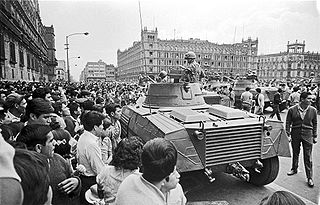
The Mexican Movement of 1968, also known as the Mexican Student Movement was a social movement composed of a broad coalition of students from Mexico's leading universities that garnered widespread public support for political change in Mexico. A major factor in its emergence publicly was the Mexican government's lavish spending to build Olympic facilities for the 1968 Olympics in Mexico City. The movement demanded greater political freedoms and an end to the authoritarianism of the PRI regime, which had been in power since 1929.

The Chiapas conflict consisted of the 1994 Zapatista uprising, the 1995 Zapatista crisis, and the subsequent tension between the Mexican state, the indigenous peoples and subsistence farmers of Chiapas from the 1990s to the 2010s.
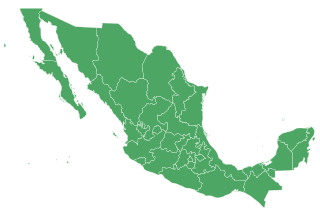
General elections were held in Mexico on 5 July 1970. The presidential elections were won by Luis Echeverría Álvarez, who received 86% of the vote. In the Chamber of Deputies election, the Institutional Revolutionary Party won 178 of the 213 seats, as well as winning all 64 seats in the Senate election. Voter turnout in the legislative elections was 64.4%.
Events in the year 1968 in Mexico.

The Apodaca prison riot occurred on 19 February 2012 at a prison in Apodaca, Nuevo León, Mexico. Mexico City officials stated that at least 44 people were killed, with another twelve injured. The Blog del Narco, a blog that documents events and people of the Mexican Drug War anonymously, reported that the actual (unofficial) death toll may be more than 70 people. The fight was between Los Zetas and the Gulf Cartel, two drug cartels that operate in northeastern Mexico. The governor of Nuevo León, Rodrigo Medina, mentioned on 20 February 2012 that 30 inmates escaped from the prison during the riot. Four days later, however, the new figures of the fugitives went down to 29. On 16 March 2012, the Attorney General's Office of Nuevo León confirmed that 37 prisoners had actually escaped on the day of the massacre. One of the fugitives, Óscar Manuel Bernal alias La Araña, is considered by the Mexican authorities to be "extremely dangerous," and is believed to be the leader of Los Zetas in the municipality of Monterrey. Some other fugitives were also leaders in the organization.
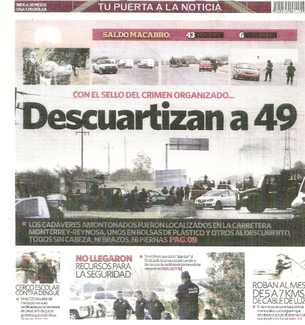
The Cadereyta Jiménez massacre occurred on the Fed 40 on 12–13 May 2012. Mexican officials stated that 49 people were decapitated and mutilated by members of Los Zetas drug cartel and dumped by a roadside near the city of Cadereyta Jiménez in northern Mexico. The Blog del Narco, a blog that documents events and people of the Mexican Drug War anonymously, reported that the actual (unofficial) death toll may be more than 68 people. The bodies were found in the town of San Juan in the municipality of Cadereyta Jiménez, Nuevo León at about 4 a.m. on a non-toll highway leading to Reynosa, Tamaulipas. The forty-three men and six women killed had their heads, feet, and hands cut off, making their identification difficult. Those killed also bore signs of torture and were stuffed in plastic bags. The arrested suspects have indicated that the victims were Gulf Cartel members, but the Mexican authorities have not ruled out the possibility that they were U.S.-bound migrants. Four days before this incident, 18 people were found decapitated and dismembered near Mexico's second largest city, Guadalajara.

José Antonio Echeverría Bianchi was a prominent figure in the Cuban Revolution against President Fulgencio Batista. Echeverría was the President of the Federation of University Students and a founding member of the militant organization Directorio Revolucionario 13 de Marzo. He is known for his role in the attack on the Presidential Palace and the Radio Reloj radio station of Cuba. Echeverría's nickname was "Manzanita," which means "Little Apple."
Halcon or Halcones may refer to:

The 2018 Nicaraguan protests began on 18 April 2018 following a move by the government of Daniel Ortega to reform social security. Following the deaths of protesters, demonstrations intensified and grew into a large anti-Ortega movement seeking his removal from office.

The Halcones were a Mexican paramilitary group created during the tail end of the 1960s and led by Colonel Manuel Díaz Escobar, the deputy director of the General Services of the Federal District Department. The group was responsible for the El Halconazo massacre on 10 June 1971, in which nearly 120 people were killed during a student demonstration in Mexico City.
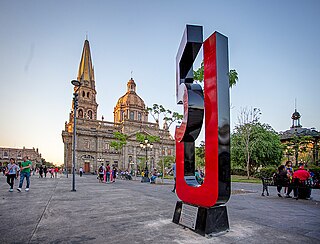
An antimonumento was installed adjacent the Antimonumenta, in the Plaza de Armas, both opposite the State Government Palace, in Guadalajara, Jalisco. The sculpture was installed by human rights groups commemorating the protests of 4, 5 and 6 June 2020, when demonstrators were repressed violently by the state police while they were protesting the death of Giovanni López the previous month.

